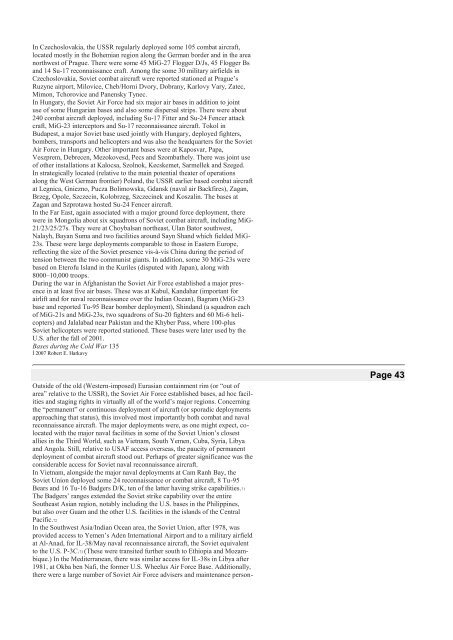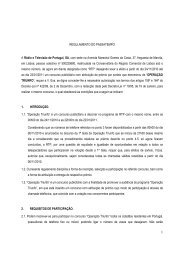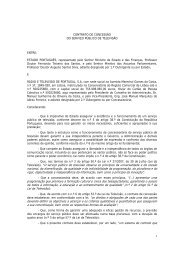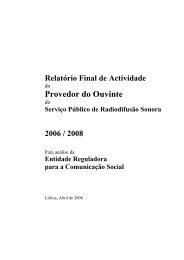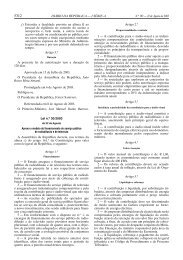6 Bases during the Cold War
6 Bases during the Cold War
6 Bases during the Cold War
You also want an ePaper? Increase the reach of your titles
YUMPU automatically turns print PDFs into web optimized ePapers that Google loves.
In Czechoslovakia, <strong>the</strong> USSR regularly deployed some 105 combat aircraft,located mostly in <strong>the</strong> Bohemian region along <strong>the</strong> German border and in <strong>the</strong> areanorthwest of Prague. There were some 45 MiG-27 Flogger D/Js, 45 Flogger Bsand 14 Su-17 reconnaissance craft. Among <strong>the</strong> some 30 military airfields inCzechoslovakia, Soviet combat aircraft were reported stationed at Prague’sRuzyne airport, Milovice, Cheb/Horni Dvory, Dobrany, Karlovy Vary, Zatec,Mimon, Tchorovice and Panensky Tynec.In Hungary, <strong>the</strong> Soviet Air Force had six major air bases in addition to jointuse of some Hungarian bases and also some dispersal strips. There were about240 combat aircraft deployed, including Su-17 Fitter and Su-24 Fencer attackcraft, MiG-23 interceptors and Su-17 reconnaissance aircraft. Tokol inBudapest, a major Soviet base used jointly with Hungary, deployed fighters,bombers, transports and helicopters and was also <strong>the</strong> headquarters for <strong>the</strong> SovietAir Force in Hungary. O<strong>the</strong>r important bases were at Kaposvar, Papa,Veszprem, Debrecen, Mezokovesd, Pecs and Szomba<strong>the</strong>ly. There was joint useof o<strong>the</strong>r installations at Kalocsa, Szolnok, Kecskemet, Sarmellek and Szeged.In strategically located (relative to <strong>the</strong> main potential <strong>the</strong>ater of operationsalong <strong>the</strong> West German frontier) Poland, <strong>the</strong> USSR earlier based combat aircraftat Legnica, Gniezno, Pucza Bolimowska, Gdansk (naval air Backfires), Zagan,Brzeg, Opole, Szczecin, Kolobrzeg, Szczecinek and Koszalin. The bases atZagan and Szprotawa hosted Su-24 Fencer aircraft.In <strong>the</strong> Far East, again associated with a major ground force deployment, <strong>the</strong>rewere in Mongolia about six squadrons of Soviet combat aircraft, including MiG-21/23/25/27s. They were at Choybalsan nor<strong>the</strong>ast, Ulan Bator southwest,Nalayh, Bayan Suma and two facilities around Sayn Shand which fielded MiG-23s. These were large deployments comparable to those in Eastern Europe,reflecting <strong>the</strong> size of <strong>the</strong> Soviet presence vis-à-vis China <strong>during</strong> <strong>the</strong> period oftension between <strong>the</strong> two communist giants. In addition, some 30 MiG-23s werebased on Eterofu Island in <strong>the</strong> Kuriles (disputed with Japan), along with8000–10,000 troops.During <strong>the</strong> war in Afghanistan <strong>the</strong> Soviet Air Force established a major presencein at least five air bases. These was at Kabul, Kandahar (important forairlift and for naval reconnaissance over <strong>the</strong> Indian Ocean), Bagram (MiG-23base and reported Tu-95 Bear bomber deployment), Shindand (a squadron eachof MiG-21s and MiG-23s, two squadrons of Su-20 fighters and 60 Mi-6 helicopters)and Jalalabad near Pakistan and <strong>the</strong> Khyber Pass, where 100-plusSoviet helicopters were reported stationed. These bases were later used by <strong>the</strong>U.S. after <strong>the</strong> fall of 2001.<strong>Bases</strong> <strong>during</strong> <strong>the</strong> <strong>Cold</strong> <strong>War</strong> 135İ 2007 Robert E. HarkavyOutside of <strong>the</strong> old (Western-imposed) Eurasian containment rim (or “out ofarea” relative to <strong>the</strong> USSR), <strong>the</strong> Soviet Air Force established bases, ad hoc facilitiesand staging rights in virtually all of <strong>the</strong> world’s major regions. Concerning<strong>the</strong> “permanent” or continuous deployment of aircraft (or sporadic deploymentsapproaching that status), this involved most importantly both combat and navalreconnaissance aircraft. The major deployments were, as one might expect, colocatedwith <strong>the</strong> major naval facilities in some of <strong>the</strong> Soviet Union’s closestallies in <strong>the</strong> Third World, such as Vietnam, South Yemen, Cuba, Syria, Libyaand Angola. Still, relative to USAF access overseas, <strong>the</strong> paucity of permanentdeployment of combat aircraft stood out. Perhaps of greater significance was <strong>the</strong>considerable access for Soviet naval reconnaissance aircraft.In Vietnam, alongside <strong>the</strong> major naval deployments at Cam Ranh Bay, <strong>the</strong>Soviet Union deployed some 24 reconnaissance or combat aircraft, 8 Tu-95Bears and 16 Tu-16 Badgers D/K, ten of <strong>the</strong> latter having strike capabilities.71The Badgers’ ranges extended <strong>the</strong> Soviet strike capability over <strong>the</strong> entireSou<strong>the</strong>ast Asian region, notably including <strong>the</strong> U.S. bases in <strong>the</strong> Philippines,but also over Guam and <strong>the</strong> o<strong>the</strong>r U.S. facilities in <strong>the</strong> islands of <strong>the</strong> CentralPacific.72In <strong>the</strong> Southwest Asia/Indian Ocean area, <strong>the</strong> Soviet Union, after 1978, wasprovided access to Yemen’s Aden International Airport and to a military airfieldat Al-Anad, for IL-38/May naval reconnaissance aircraft, <strong>the</strong> Soviet equivalentto <strong>the</strong> U.S. P-3C.73 (These were transited fur<strong>the</strong>r south to Ethiopia and Mozambique.)In <strong>the</strong> Mediterranean, <strong>the</strong>re was similar access for IL-38s in Libya after1981, at Okba ben Nafi, <strong>the</strong> former U.S. Wheelus Air Force Base. Additionally,<strong>the</strong>re were a large number of Soviet Air Force advisers and maintenance person-Page 43


